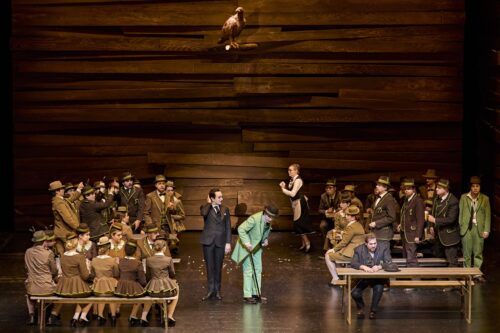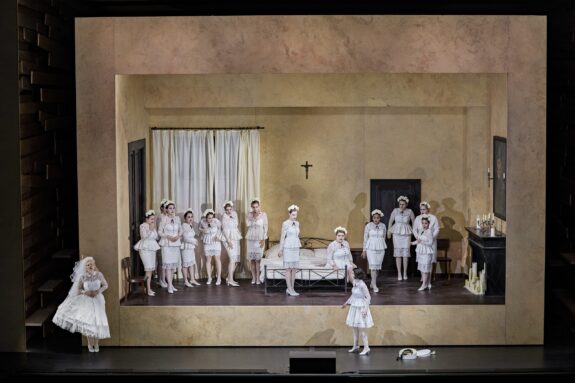 Germany Weber, Der Freischütz: Soloists and Chorus of Hamburg State Opera, Hamburg Philharmonic State Orchestra / Yoel Gamzou (conductor). Hamburg State Opera, Hamburg, 23.11.2024. (DM-D)
Germany Weber, Der Freischütz: Soloists and Chorus of Hamburg State Opera, Hamburg Philharmonic State Orchestra / Yoel Gamzou (conductor). Hamburg State Opera, Hamburg, 23.11.2024. (DM-D)

Production:
Director – Andreas Kriegenburg
Set design – Harald B. Thor
Costume design – Andrea Schraad
Lighting – Andreas Grüter
Dramaturgy – Angela Beuerle
Choreography – Volker Michl
Chorus director – Christian Günther
Cast:
Ottokar – Andrzej Dobber
Max – Maximilian Schmitt
Agathe – Julia Kleiter
Ännchen– Alina Wunderlin
Caspar – Johan Reuter
Samiel – Clemens Sienknecht
Hermit – Han Kim
Kilian – William Desbiens
Cuno – Hubert Kowalczyk
Bridal maidens – Angelka Gajtanovska, Lilian Giovanni, Marina Ber, Veselina Teneva
A permanent set of walls to the left, the right and at the back of the stage, consisting of rugged, dark wooden boards as high as the stage, provided the visual frame for this production. Those walls were shifted, sometimes by the stage machinery, sometimes by members of cast and chorus, to form different angles, while an imaginative use of lighting created different locales within this frame – especially impressive for the wolf’s glen scene. The back piece of that frame revolved to reveal the brightly lit and pleasant interior of Agathe’s chamber, with a door leading to her washroom. The room was moved towards the ramp for the scenes in which it was used. Its design emphasised the stark contrast of pleasant, smooth femininity with the rough male environments.
Within the world of the woods, the hunters were dressed in smug, functional, traditional suits in various shades of brown, with their leaders (Ottokar, Cuno, Caspar) in contrasting shades of green. Max wore a black suit, emphasizing his status as an outsider. The hermit was clad in a gleaming white robe. The women, Agathe and Ännchen, were mainly dressed in white as well. Overall, the costume design fitted in well with the set design and the overall angle adopted by the production.
Director Andreas Kriegenburg chose to use almost all of the spoken dialogue as originally written, rather than cutting it or changing it. As a result, the production lasted 200 minutes rather than the more usual 150, including interval. Kriegenburg chose to make Samiel a 1920s master of ceremonies, of the kind known from the musical Cabaret. He was almost always on the stage and seemed to influence everyone’s behaviour by virtue of his very presence. Clemens Sienknecht gave him a very strong, Mephisto-like and dangerous presence. The combination of long passages of spoken dialogue and music led to an inherent distancing effect, allowing the plot to develop in the very clear mode of observation from the outside – almost Brechtian.
The cast assembled for this production was an interesting mix of singers in at least four distinctly discernible categories: visiting artists for whom Hamburg State Opera was just one stop within the international circuit of Munich, Salzburg, London, or Berlin; members of the resident Hamburg State Opera company and members of the company’s International Opera Studio. Thus, there were achievements to admire, some work in the category of very promising and to be looking out for in the future, and some very reliable, rock-solid artistic work. This wide range of categories was ever obvious throughout the production; it meant that the overall impression in terms of the singing did not come across as consistent, as it often can, even at smaller opera houses with companies having a more homogenous pool of resident artists with only a few visiting artists integrated into them.

Julia Kleiter was outstanding as Agathe: her mellow voice came across as savouring the nuances of the music composed for her. Alina Wunderlin combined witty acting with very agile command of the intricacies of the coloratura. Johan Reuter as Caspar seemed to have a particularly large number of lines of (well-presented) spoken dialogue in addition to his robust singing. Maximilian Schmitt as Max rose to the challenge of combining the lyrical and the more dramatic material of his voice as demanded by the score, without sounding too beefy for the former or having to force his voice for the latter. Andrzej Dobber was authoritative as Ottokar, William Desbiens contributed a well-rounded portrayal as Kilian, Hubert Kowalcyk was as strong in voice as he acted feeble in body as Cuno, while Han Kim as the Hermit compensated for a lack of volume with musicality in his phrasing. Clemens Sienknecht gave Samiel a threatening aura of evil.
Yoel Gamzou led the orchestra through a very lively, committed performance, clearly relishing the rich unisono of the strings, and supporting the singers with tempos that suited their different backgrounds and circumstances.
Daniel Meyer-Dinkgräfe
